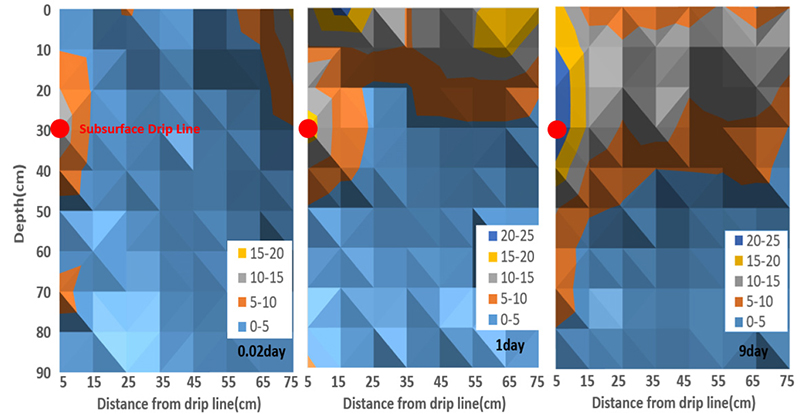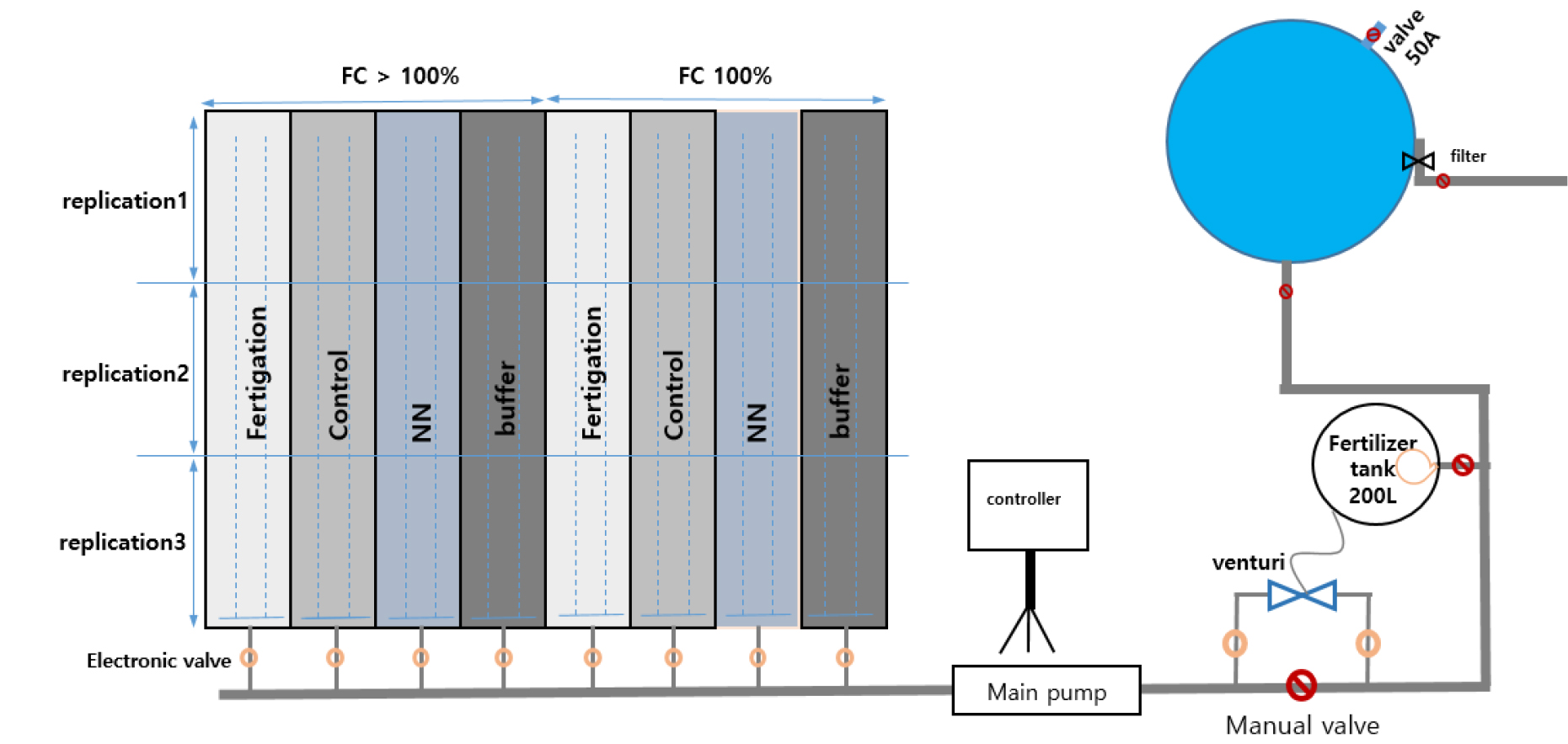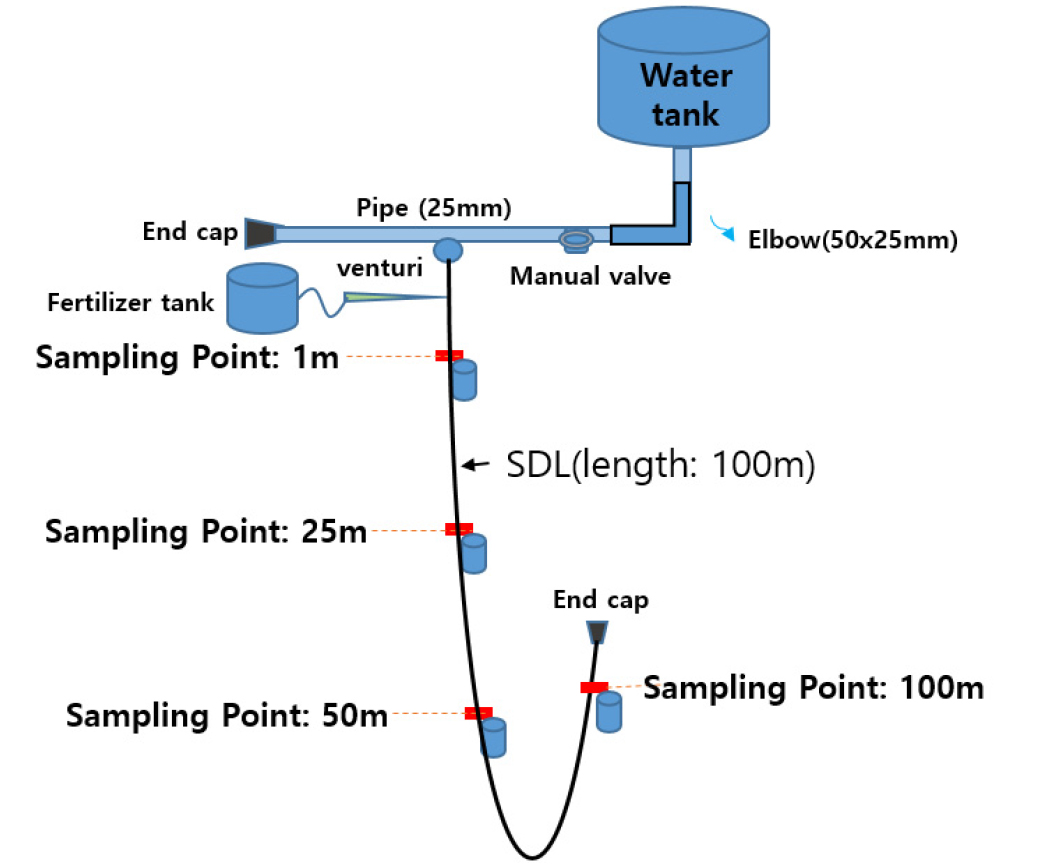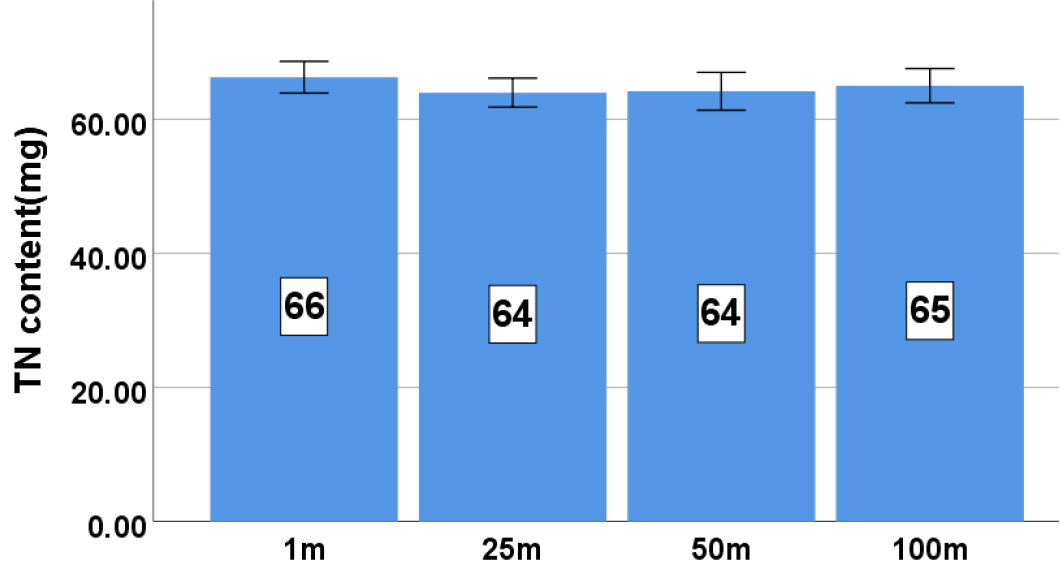Introduction
Materials and Methods
옥수수 재배
처리구 구성 및 배관 시스템
토양 분석
옥수수 생육 및 수량 특성 분석
관비시스템 성능 평가 배관 구성
통계처리
Results and Discussion
토양수분별 옥수수 생육 ‧ 이삭 비교
관비시스템 적용 옥수수 재배 토양수분별 수량 비교
관비시스템 성능 평가
Conclusions
Introduction
관비는 수용성 비료 또는 액비를 관개관을 통해 투입하는 형태를 일컫는다 (Geleta et al., 1994; Roth et al., 1995). 관비 정의에서 나타났듯이, 관비는 비료를 스프링클러 또는 점적관을 통해 정밀하게 공급하는 것을 의미한다. 관비를 점적관에 주입하는 방법은 원수 라인을 비료 탱크에 직접 연결하는 법, 원수 라인에 펌프 ‧ 벤츄리와 같은 기계장치를 연결해 비료를 주입하는 방법 등이 있다 (Biswas, 2010). 이러한 관비는 작물 재배를 용이하게 하고 관수/비료 사용 효율성을 증가시킨다. 효율성을 높여 비료 사용량을 줄이면 지표 또는 지하로 유출되는 비료를 줄여 비료 사용으로 인한 환경오염도 줄일 수 있어 관비 방법에 대해 계속 연구되어왔다 (Hagin and Lowengart, 1995; Li et al., 2004).
최근에는 관비를 지중점적관개관에 적용하여 토양 내 근권부로 직접 양분을 투입하는 방식으로 발전하였다. 지중점적관개관은 점적관을 지표에 설치하는 것이 아니라 지중에 매설하여 수분/관비를 공급한다 (Girma and Jemal, 2015). 지중 점적 관비 주입을 활용하면 양분이 뿌리 주위에 집중되도록 하는 효과를 볼 수 있다. Coelho and Or (1999)은 지중 점적 관비 주입이 전반적인 뿌리 활동성을 향상시킨다고 밝혔다. 이 연구에서는 지중 점적 관비 주입이 공급된 양분의 이동성을 개선해 뿌리로의 접근성을 향상시키므로 뿌리의 양분 흡수성을 증가시켰음을 밝혔다. Dhake et al. (2009)은 지중 점적 관개관을 활용한 비료 공급은 토마토의 질소, 인산, 칼륨 흡수율을 증가시켰다고 보고했다. Shedeed et al. (2009)은 지중 점적 관개관을 활용한 비료 공급이 질소, 인산, 칼륨 흡수량과 회수율을 증가시켜 비료 이용 효율을 높였고, 결과적으로 수량을 증가시켰다고 밝혔다. Lee et al. (2021)은 관비 공급으로 비료 이용 효율이 질소는 75% 인산은 64%까지 향상된다고 밝혔고, Kim and Rho (2022)는 관비 공급으로 감자 재배 시 수확량이 27%가량 증수되었다고 보고했다.
노지에 적합한 지중 점적 관비 시스템은 물/비료의 지표 또는 지하로의 유출을 최소화하면서 작물 수량을 증가시킨다 (Gärdenäs et al., 2005). 이에 작물에 공급하는 비료 양을 줄여도 동일한 수확량을 얻을 수 있다. Kwong et al. (1999)은 N 비료를 30% 절감했을 때 사탕수수 수량이 관행 농법과 차이가 없다고 밝혔다. Singh et al. (2010)은 지중 점적 관개관을 통한 비료 공급으로 작물의 수량이 8 - 41% 증가하였고, 비료 사용량이 20 - 60% 절감하였다고 밝혔다. 기존 연구들에서도 옥수수 (Chauhdary et al., 2017), 토마토 (Dhake et al., 2009)를 재배할 때 관비를 적용할 경우 작물 수량성이 증가하는 것으로 나타났다.
지중 점적관을 활용한 관비 시스템은 해외에서 지난 30년 동안 노지재배에 적용되고 개발되어왔다. Martinez Hernandez et al. (1991)은 미국에서 옥수수 재배 시 지표 관비와 지중 관비의 차이를 비교하였다. 이 연구에서 P, K 흡수율과 수량성에서 지중 관비가 더 효과가 좋다는 결과를 보였다. 이후 여러 작물 노지재배에 지중 점적관을 활용한 관비시스템을 적용하였다; 목화 (Janat and Somi, 2001; Aujla et al., 2005), 옥수수 (Lamm et al., 2004), 사탕무 (Rajasekaran, 2007) 등. 이 연구들은 공통적으로 질소 흡수율, 수량 그리고 수분이용 효율이 향상되었다고 결론을 지었다. 이후 관비시스템 개발뿐만 아니라 관비에 적합한 비료 형태 (Raman et al., 2000; Tumbare and Bhoite, 2002), 비료 사용 효율성 (Burt, 1998; Veeranna et al., 2001), 그리고 관비 스케줄링 (Tumbare and Bhoite, 2002)에 대한 연구로 발전해 나갔다. 외국에서는 작물의 노지재배에 관비시스템의 적용과 기술 개발이 활발히 이루어지고 있으나 현재까지 우리나라 노지재배에서 지중 점적관을 이용한 관비시스템이 적용된 사례는 없었다.
최근 국내에서 농업인력의 감소와 고령화가 빠르게 진행되고 있다 (KOSAT, 2022) (2021년 농가 인구는 221만 5,000명으로 전년 대비 4.3% 감소, 65세 이상 고령인구는 2020년 42.3%에서 2021년 46.8%로 4.5% p 증가). 이에 기존 농작업에 필요한 노동력을 최소화 또는 자동화하는 방향으로 나아가고 있다. 이러한 농업환경 여건은 지중 점적관개와 이를 통한 관비시스템의 활용에 대한 필요성이 높아지고 있으나 현재까지 국내 노지재배에서 지중 점적관을 활용한 관비시스템의 적용은 이루어지지 않았다.
본 연구에서는 국내 농업환경에 적합한 관비시스템을 개발하고 시스템의 효율성을 평가하기 위해 옥수수 노지재배 시 관비시스템의 질소 균일성, 분포 변화와 옥수수 수량성을 분석하였다.
Materials and Methods
옥수수 재배
본 연구는 국립식량과학원 남부작물부내 (경상남도 밀양시) 포장에서 2020년 3월부터 2021년 7월까지 수행하였다. 옥수수 품종은 일미찰 (Ilmichal)이었고, 2020년 6월 10일, 2021년 5월 19일에 파종하였다. 1주 1본을 가로 60 cm 세로 25 cm 간격으로 심어서 재배하였다 (Fig. 1). 파종 전 시비량은 작물별 비료 사용 처방 기준 (RDA, 2021)에 따라 N-P2O5-K2O = 7.25-3-6 kg 10a-1의 양을 기비로 시비하였고, 옥수수 V11 시기에 7.25 kg 10a-1의 질소를 추비로 시비하였다. V11 시기는 옥수수에서 자엽을 제외하고 잎이 11개째 출현한 시기를 말한다. 관비구는 질소 기비와 질소 추비에 요소 비료 (슈퍼 알알이, 질소 46%)를 물에 충분히 녹여 관주하였고, 기비 중 인산 (용성인비, 인산 17%)과 가리 (염화가리, 칼리 60%)는 표토에 시비하였다. 대조구는 질소 기비와 질소 추비를 관비구와 같은 시기에 표토에 시비하였다. 파종 후 옥수수 재배는 농촌진흥청 표준재배법에 준하였다.
처리구 구성 및 배관 시스템
실험은 두 가지 처리로 이루어졌다. 토양수분함량 처리는 각각 포장용수량 (field capacity, FC) 100%, FC > 100%로 유지하였다. (Ko and Piccinni, 2009)은 토양수분 함량에 따라 관비 시 옥수수 수량이 다르다고 보고하였고, 이에 따라, 토양 수분은 파종 직후부터 수확까지 각각 FC 100%, FC > 100%로 유지하였다. 여기서, FC 100%는 토양을 채취해 압력챔버 (1600 extractor, Soilmoisture equipment corp, USA)를 이용해 0.3기압에서 측정된 값 25.7%를 기준하여 25% (v v-1)로 정하였고, FC > 100%는 30% (v v-1)로 설정하였다. 토양수분함량은 수분 센서가 설치된 지하 20 cm에서 측정하였고, 계측값을 바탕으로 위에서 설정한 값 (25%, 30%)을 지하 20 cm를 기준하여 유지하였다. 시비 방법 처리는 관비 주입구, 대조구, 무처리로 이루어졌다. 각 처리구는 34 m (가로) × 2.4 m (세로)로 구성해 총 9개의 처리구에서 옥수수를 재배하였다 (Fig. 2). 지중 점적관 (Uniram, Netafim, Israel)은 1 처리구당 120 cm 간격으로 2줄 설치하였고, 1줄당 34 m 길이로 설치되었다. 총 18줄의 지중 점적관을 설치하였다.
지하관정과 1 ton 물탱크 사이에 50 mm PE 용수관을 연결하였고, 관비 주입을 위한 시스템인 벤츄리를 연결하였다. 벤츄리에는 전자밸브를 설치하여 제어기와 연결해 특정 처리구에서만 작동하도록 설계하였다. 벤츄리 이후는 50 mm PE용수관을 포장과 나란히 연결하였고, 25 mm PE용수관을 사용해 지중 점적관과 연결하였다. 지중 점적관의 선단부에는 전자밸브 (solenoid valve, bermad, Israel)를 제어기와 연계해 자동으로 관수를 하였다. 자동 관수는 제어기와 연결된 토양수분 센서에서 읽히는 값을 기준으로 하였다. 지중 점적관은 압력 보상 기능, 낙수 방지, 뿌리 막힘 방지 기능이 있는 제품을 이용하였다. 지중 점적관의 재질은 경질관이고, 내경 14.2 mm, 두께 1 mm, 점적기 간격은 20 cm, 최대 허용 압력은 350 kPa이며 각 점적기마다 시간당 2.3 L의 수분을 공급하였다. 점적관을 30 cm 깊이에 설치하여 목표하는 토양수분 값이 유지되도록 관수를 공급하였다.
각 처리구는 토양수분 센서 (Terros 12, METER, USA)를 설치하여 20 cm 깊이에서 1 시간마다 토양수분 함량, 토양 온도, 토양 EC를 측정하였다. Bhattarai et al. (2008)은 지중 점적관 시스템에서 토양 깊이별 토양수분의 변화를 분석한 결과, 20 cm 깊이까지 토양수분 함량은 기상조건에 따라 급격한 변화를 보이나 20 cm 이후부터는 안정적인 값을 유지한다는 것을 밝혔다. 이와 같은 연구결과에 따라 본 연구에서는 안정적인 토양수분 값을 얻고자 20 cm 깊이에서 토양수분을 측정하였다. 처리구들은 개별적으로 토양수분 함량을 기반으로 자동으로 조절 및 제어가 가능하도록 자동관수 시스템을 설치하였다. 이를 통해서 생육 기간 동안 원하는 토양수분함량이 유지되도록 하였다 (Table 1).
Table 1.
Average and standard deviation results of soil moisture, soil temperature, soil electrical conductivity from automatic subsurface drip irrigation.
토양 분석
옥수수 파종 전에 토양 시료를 채취하여 토성과 화학성 (pH, EC, 유기물, 교환성 양이온 (Ca, Mg, Na, K)), 유효인산 (available P2O5)을 분석하였다. 농촌진흥청 토양화학 분석 법 (NAAS, 2010)에 따라 분석하였다. 실험 토양 분석 결과 작물 재배에 적합한 화학성을 보였다 (Table 2).
Table 2.
Average results of soil chemical and physical analysis (2020, 2021).
옥수수 생육 및 수량 특성 분석
옥수수 생육특성 및 수량구성요소를 옥수수 수확 시기에 주요 밭작물 시험 연구 조사 기준 필드 북 (RDA, 2021)에 준하여 조사하였다.
관비시스템 성능 평가 배관 구성
토출되는 양분의 균일성을 시험하기 위해 남부작물부 부내 시험 온실에 Fig. 3과 같은 관비시스템을 설치했다. 온실에 설치한 모형은 포장에 설치한 관비시스템의 축소판이다. 실험을 위해 지상에 100 m 길이의 지중 점적관을 설치했다. 점적관 시작부위에 포장시험과 동일한 규격의 벤츄리를 설치했다. 벤츄리에 주입한 양액은 물 4 L에 요소 200 g을 균일하게 섞었다. 양액은 관수가 시작된 후 3분부터 18분까지 총 15분간 주입했다. 양분의 균일성을 검증하기 위해 1 m, 25 m, 50 m, 100 m에 위치한 점적 공에서 토출 수를 일정 시간 동안 채취했다. 채취한 시료의 질소 농도는 Kjeldahl 방법으로 분석했다.
양분의 토양 내 이동을 평가하기 위해 포장에 설치된 지중 점적관, 관비시스템을 활용하였다. 양액은 물 200 L에 요소 1 kg을 균일하게 섞었다. 시험 첫날에만 양액과 관수를 주입했고, 양액을 90초 주입한 후 물을 9분간 주입했다. 기간별 (+0.02 day, +1 day, +9 day)로 샘플링을 하였으며, 샘플링 위치는 Fig. 4와 같다. 총 질소 (total nitrogen, TN),질 암모늄태 질소 (ammonium nitrogen, NH4), 질산태 질소 (nitrate nitrogen, NO3)를 AA 기 (AA500, Seal Analytical, USA), Kjeldahl 기기 (KjeltecTM Sampler 8420, FOSS, Denmark)를 이용해 분석하였고, 분석 방법은 식량작물환경 분석 법 핸드북 (RDA, 2014)에 준하여 조사하였다.
통계처리
통계 분석은 SPSS program (IBM, v.27, New York, USA)을 사용하여 ANOVA (analysis of variance)를 95% 유의수준에서 분석하였다. 옥수수 생육 및 수량구성요소는 주요 밭작물 시험 연구 조사 기준 필드 북 (RDA, 2021)에 준하여 반복하였고, 지중 점적관 토출 양분의 균일성 및 분포양상 분석은 3반복으로 수행됐다. 모든 데이터 값은 표준 값 ± 표준 편차로 나타냈으며, 동일한 토양수분함량 처리 안에서 시비방법별로 통계 분석하였다.
Results and Discussion
토양수분별 옥수수 생육 ‧ 이삭 비교
관비 처리에 따른 옥수수 생육 ‧ 이삭 특성 분석 결과는 Tables 3, 4와 같다. 2020년 FC 100% 처리구에서 1이삭 중은 관비구 207.33 ± 17.19 g, 대조구 193.33 ± 10.86 g으로 1이삭중이 관비구가 대조구보다 14 g 높았다. 이삭 직경은 대조구 37.34 ± 0.30 mm, 관비구 38.72 ± 0.33 mm로 유의성이 있는 차이가 나타나지 않았지만, 관비구에서 이삭 직경이 큰 경향이 나타났다. 2021년에도 FC 100% 처리구에서 1이삭 중은 관비구 146.04 ± 8.51 g, 대조구 144.44 ± 2.31 g으로 유의성 있는 차이가 나타나지 않았지만, 관비구에서 1이삭 중이 무거운 경향이 나타났고, FC > 100% 처리구에서는 1이삭 중이 관비구 156.84 ± 2.60 g, 대조구 145.64 ± 1.08 g으로 1이삭 중이 관비구가 대조구보다 11 g 높았다.
Table 3.
Average and standard deviation results of growth and ear characteristics of corn with soil moisture corresponding to field capacity when using subsurface fertigation (2020).
Table 4.
Average and standard deviation results of growth and ear characteristics of corn with soil moisture corresponding to field capacity when using subsurface fertigation (2021).
관비시스템 적용 옥수수 재배 토양수분별 수량 비교
토양수분에 따른 옥수수 수량 분석 결과는 Tables 5, 6과 같다. 2020년 FC 100% 처리구에서는 관비구 수량이 대조구보다 128 kg 10a-1 유의성 있게 높았고, FC > 100% 처리구에서는 관비 처리구 수량과 대조구 수량이 유의성 있는 차이를 나타내지 않았고 (p > 0.05), 2021년에는 FC 100% 처리구에서는 관비구 수량이 대조구보다 367 kg 10a-1 유의성 있게 높았다. FC > 100%에서는 관비 처리구 수량이 대조구 수량보다 595 kg 10a-1 증수했다 (p > 0.05). Aubert et al. (2016)이 보고한 결과와 마찬가지로 관비 시비 시 표토 시비보다 옥수수 수량이 증수하였으며, 또한 Patil et al. (2012)이 보고한 결과처럼 관비를 했을 때 대조구보다 옥수수 수량이 높아졌다. 이는 관비 시비가 표토 시비보다 작물의 영양분 (nitrogen, potassium 등)의 흡수량을 높이기 때문이라고 보고하였다. 이에 따라 관비 시비는 비료를 옥수수 뿌리와 가까운 토양에 분사해 양분이용 효율이 증가시키므로 수량을 증수시키는 것으로 사료된다.
Table 5.
Average and standard deviation results of yields of corn with soil moisture control when using subsurface fertigation (2020).
Table 6.
Average and standard deviation results of yields of corn with soil moisture control when using subsurface fertigation (2021).
관비시스템 성능 평가
관비시스템의 성능을 평가하기 위해 거리에 따라 토출되는 양분의 균일성, 관비 주입 후 양분의 토양 내 이동 양상을 분석하였다. 거리별 양분 균일성 시험의 결과 점적관 거리에 따른 관비 총량 분석 결과는 Fig. 5와 같다. 1 m, 25 m, 50 m, 100 m에서 질소 총 토출량은 각각 66.27 ± 0.96 mg, 63.98 ± 0.88 mg, 64.18 ± 1.15 mg, 65.01 ± 1.04 mg으로 점적관의 거리에 따라 양분 토출량은 유의적인 차이를 보이지 않았다 (p > 0.05). 따라서 위의 결과를 토대로 지중 점적관을 활용한 관비는 100 m 이하 관에서 거리에 관계없이 양분이 균일하게 토출된 것으로 보인다. 이는 지중 점적관의 점적 공에서 유출량이 일정하며 (Lee et al., 2020) 벤츄리 장치를 사용하면 비료가 균일하게 섞이기 때문으로 사료된다 (Kumar et al., 2012).
양분의 토양 내 이동을 평가하기 위해 지중 점적관을 통해 요소태 관비 주입 후 시간에 따른 토양 내 이온 농도를 측정하였다. TN (%nitrogen)과 NH4+-N는 관비 주입 후 시간 (+0.02 day, +1 day, +9 day)에 따른 농도의 변화가 나타나지 않았다 (Figs. 6, 7). NO3--N는 관비 주입 1일 후 토양 상부 (0 - 50 cm)에 우선 유출되었고, 9일 후 상부에 고루 퍼진 것으로 나타났다 (Fig. 8). 이는 관비가 토양 상부로 공급되어 작물에 안정적으로 양분을 공급할 수 있다는 것을 나타낸다. 위 결과는 Eltarabily et al. (2019)이 보고한 결과와는 다른 양분 이동 양상을 띈다. 이는 하나의 토성에서만 시뮬레이션을 한 결과이기 때문에 여러 토양 층위가 나타나는 실제 토양과 결과가 다른 것으로 사료된다.
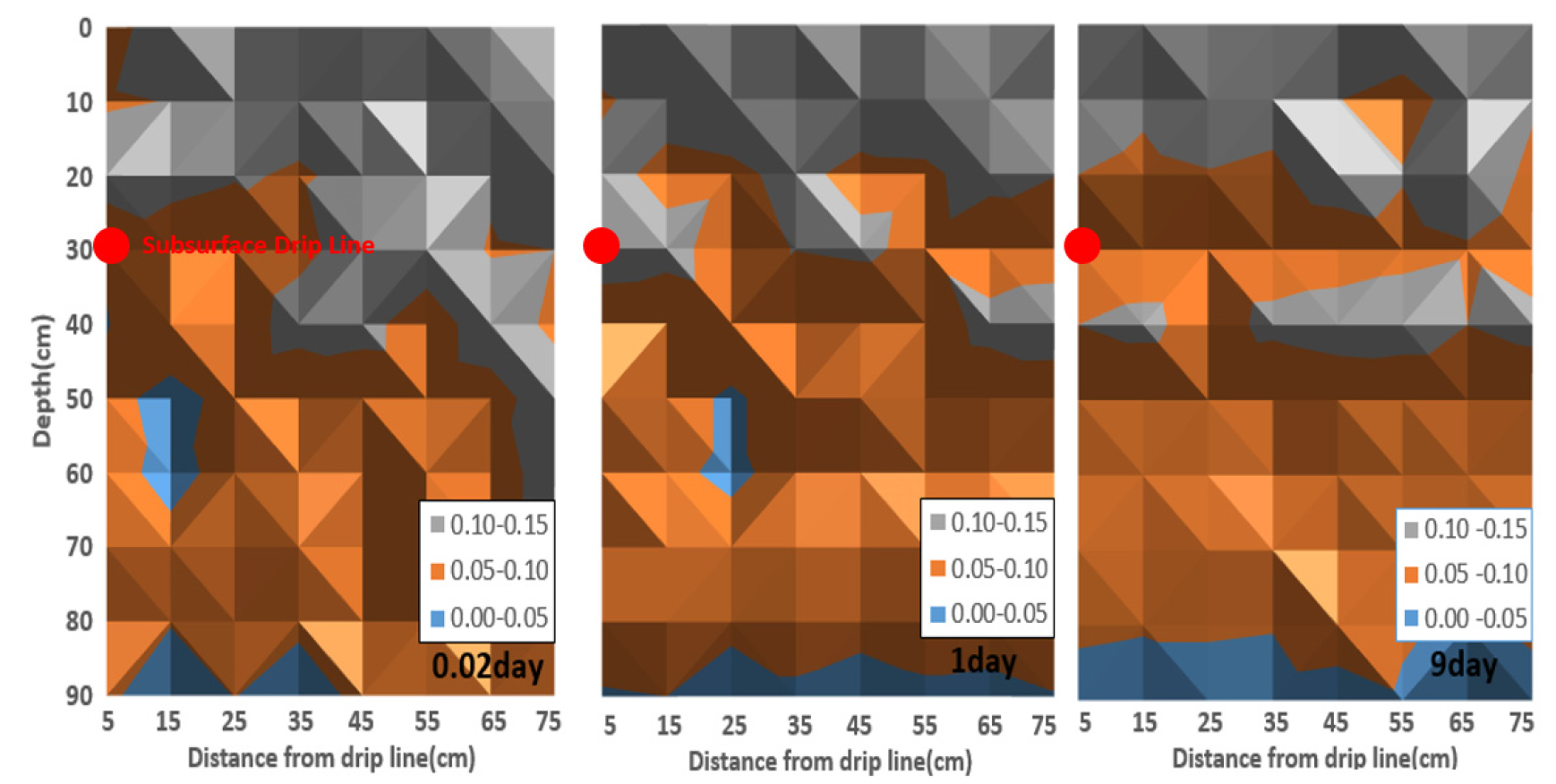
Fig. 6.
Distributions of total nitrogen content in the soil released from the subsurface drip over time; red dot: location of subsurface drip line (SDL), unit of legend: %nitrogen - Each color represents a certain range of values, nday: n day after fertigation, experiments were conducted by three replicates.
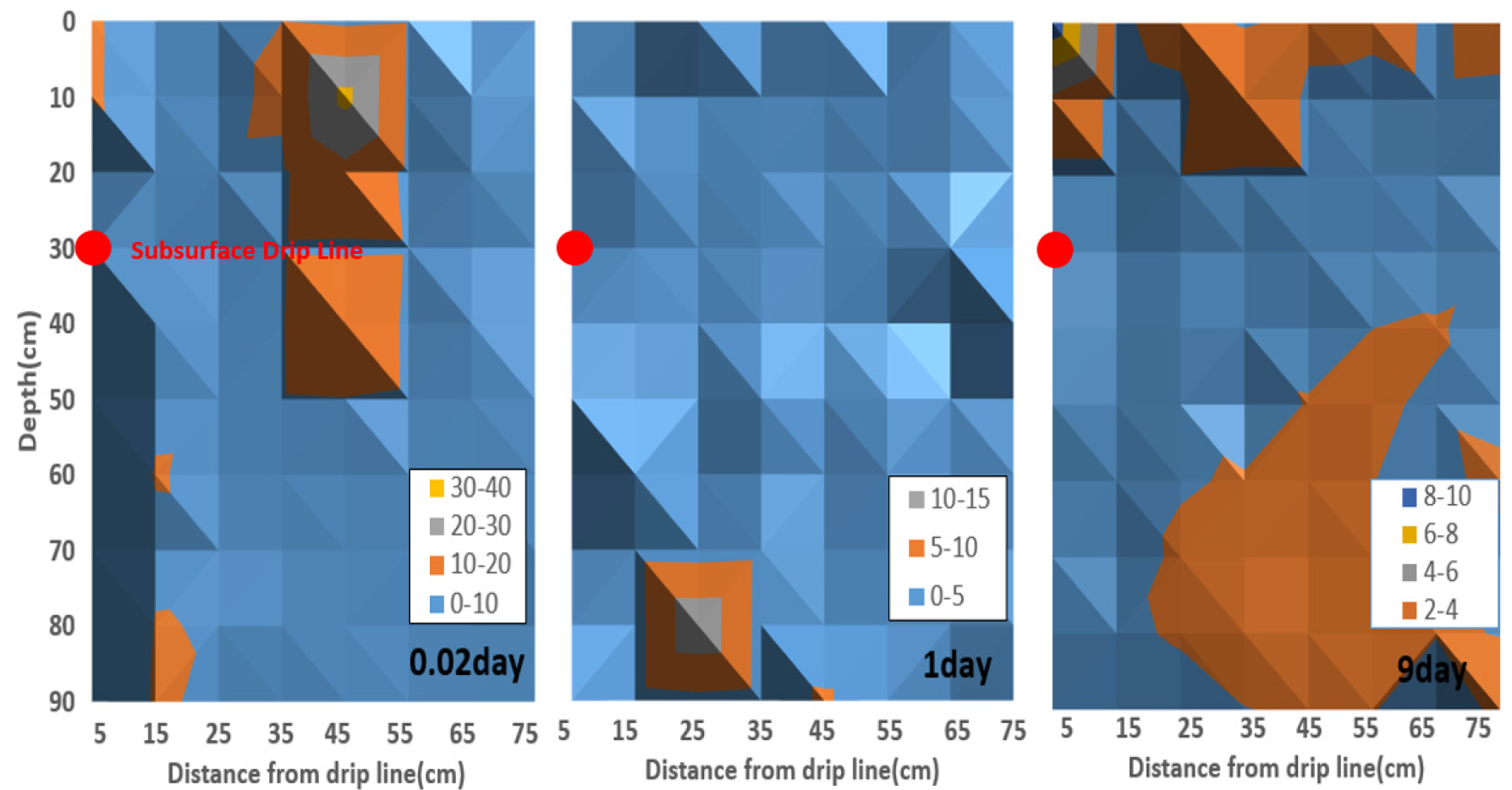
Fig. 7.
Distributions of ammonium ion content in the soil released from the subsurface drip over time; red dot: location of subsurface drip line (SDL), unit of legend: ammonium ion concentration (mg kg-1) - Each color represents a certain range of values, nday: n day after fertigation, experiments were conducted by three replicates.
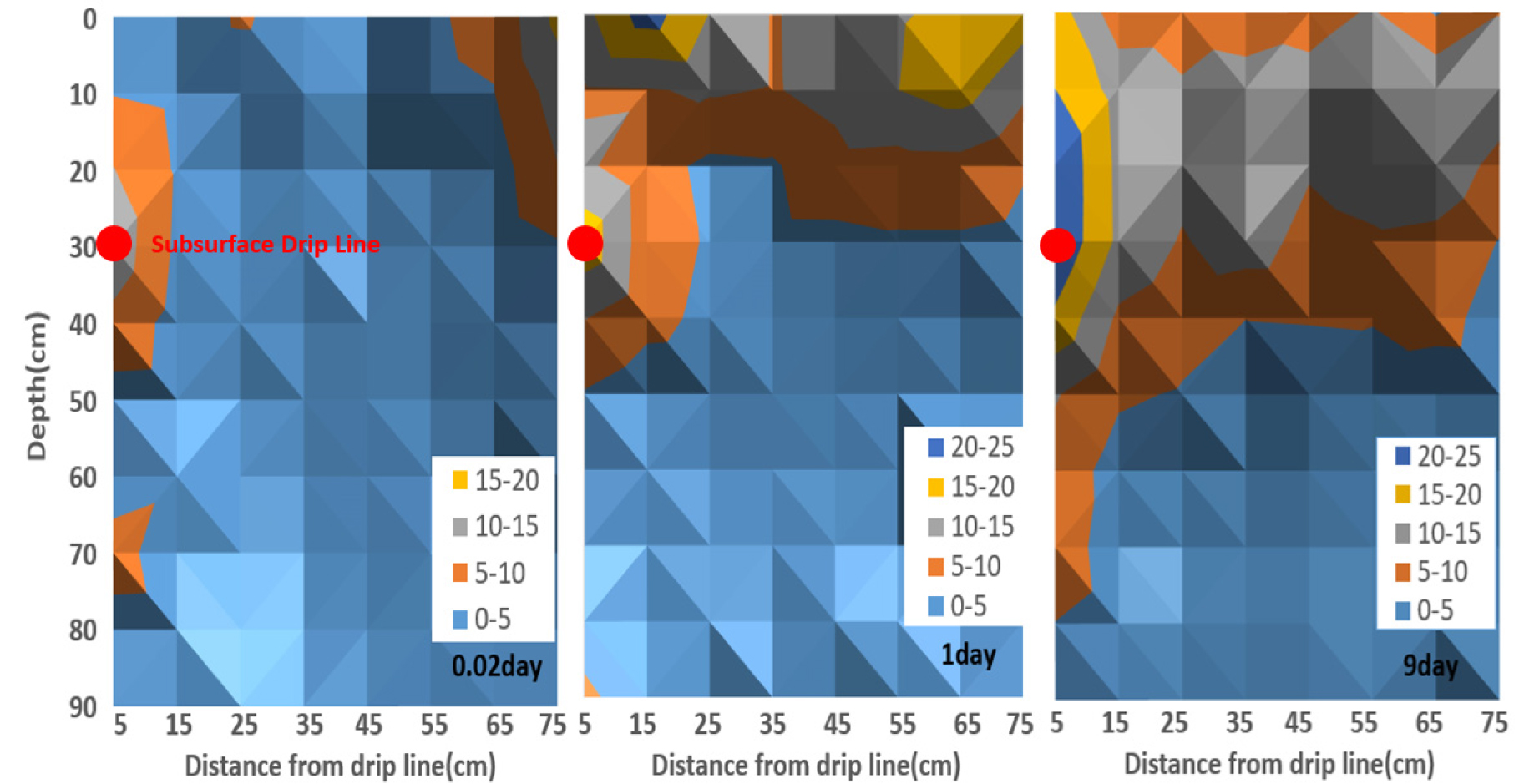
Fig. 8.
Distributions of nitrate content in the soil released from the subsurface drip over time; red dot: location of subsurface drip line (SDL), unit of legend: nitrate concentration (mg kg-1) - Each color represents a certain range of values, nday: n day after fertigation, experiments were conducted by three replicates.
Srayeddin and Doussan (2009)이 보고한 결과에 따르면 옥수수 작물의 뿌리는 토양으로부터 0 - 30 cm 이내에서 흡수가 가장 활발하다. 따라서, 지중 점적관을 통해 토출된 양분이 작물의 뿌리에 직접적으로 공급돼 양분이용 효율을 향상시킬 것이라 보인다.



